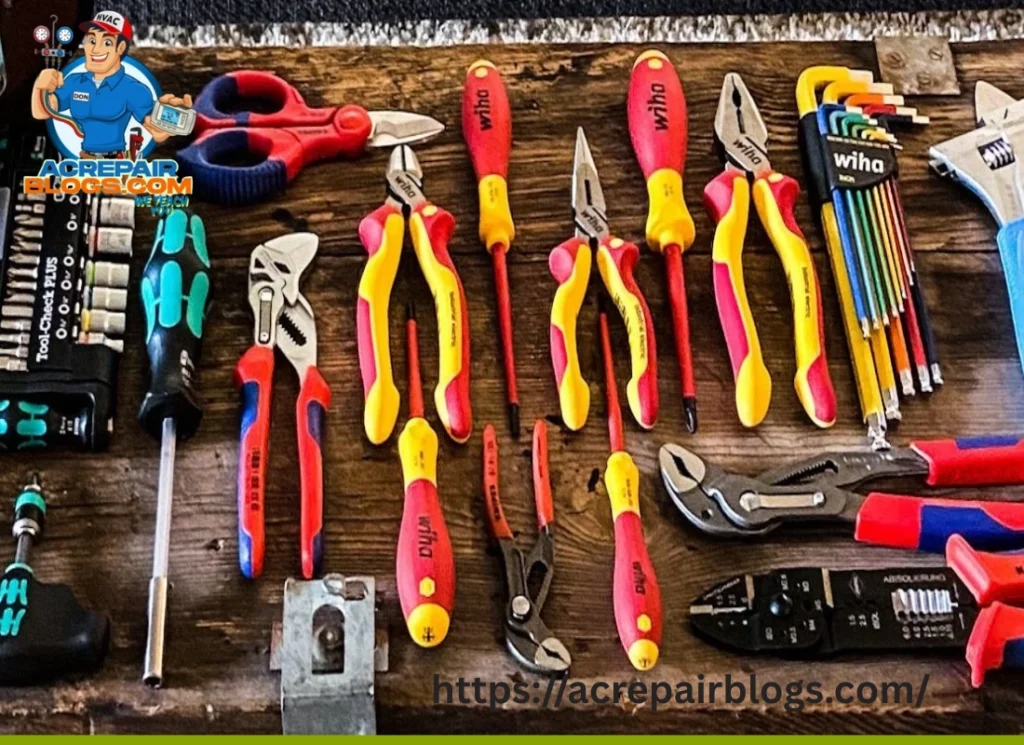Introduction
When it comes to keeping your air conditioner running smoothly, having the right tools on hand can make all the difference. While regular professional service is important, many homeowners are turning to DIY maintenance to save money and extend the life of their AC systems. But before you dive in, you’ll need a proper air conditioner repair tool kit.
In this guide, we’ll cover the top 10 AC maintenance tools every DIYer should have, explain why each one is essential, and share practical tips on how to use them safely and effectively.
Why Tools Matter for DIY AC Maintenance
Air conditioners are complex systems with electrical, mechanical, and refrigerant components. Attempting maintenance without the right tools can not only damage your unit but also pose safety risks. A well-prepared AC maintenance toolkit:
- Saves money on minor repairs and filter replacements.
- Helps prevent costly breakdowns.
- Empowers you to troubleshoot issues before calling a technician.
- Extends the overall lifespan of your system.
Top 10 Hand Tools Every DIYer Needs
1. Screwdrivers (Flathead & Phillips)
Every air conditioner has panels, covers, and components held together by screws. A reliable set of screwdrivers is a must.
- Use: Removing access panels, replacing filters, tightening loose connections.
- Tip: Invest in an insulated screwdriver set for added safety when working around electrical parts.
2. Adjustable Wrench
When you need to tighten or loosen bolts and nuts, especially around connections or brackets, an adjustable wrench is your best friend.
- Use: Adjusting fittings, securing mounting bolts, or tightening fan blades.
- Tip: Choose a wrench with a comfortable grip to avoid hand fatigue during longer tasks.
3. Pliers (Needle-Nose & Slip-Joint)
Pliers come in handy for gripping, bending, and cutting wires or other small components inside the unit.
- Use: Handling electrical wires, adjusting copper tubing, or pulling out damaged parts.
- Tip: Needle-nose pliers are especially useful in tight spaces where fingers can’t reach.
4. Multimeter
If you plan to do more than surface-level maintenance, a multimeter is essential for diagnosing electrical issues safely.
- Use: Testing voltage, continuity, and current in your AC system.
- Tip: Learn how to use it properly before testing live wires. Safety first!
5. Fin Comb
Your AC’s condenser and evaporator coils have delicate fins that can bend easily, reducing airflow and efficiency. A fin comb helps restore them.
- Use: Straightening bent fins to improve airflow and cooling performance.
- Tip: Match the fin comb size to the fin spacing of your coils for best results.
6. Refrigerant Gauge Set
While most refrigerant-related work should be left to licensed professionals, DIYers can use a gauge set to check system pressures and get an idea of refrigerant health.
- Use: Connecting to service ports to measure pressure levels.
- Tip: Never attempt to add refrigerant yourself unless certified it’s both unsafe and illegal in many areas.
7. Cordless Drill
When dealing with multiple screws, a cordless drill saves time and effort. It’s also useful for mounting or securing AC brackets.
- Use: Removing access panels quickly, securing brackets, or drilling pilot holes.
- Tip: Keep an assortment of bits ready to match different screw types.
8. HVAC Thermometer
A reliable thermometer helps you measure air temperature from supply and return vents, giving you insight into your AC’s performance.
- Use: Checking temperature differential to spot cooling issues.
- Tip: Digital thermometers offer faster and more accurate readings than traditional ones.
9. Flashlight or Headlamp
AC units often have dark, cramped spaces that are hard to inspect without proper lighting.
- Use: Inspecting coils, ductwork, and internal wiring.
- Tip: A headlamp keeps your hands free while working inside tight spaces.
10. Shop Vacuum
Dust, dirt, and debris buildup inside your AC can affect efficiency. A shop vacuum is a powerful tool to keep the system clean.
- Use: Cleaning condenser coils, air vents, and drain lines.
- Tip: Use a soft brush attachment to avoid damaging delicate parts.
Bonus Tools for Serious DIYers
While the above tools are essentials, if you want to level up your air conditioner repair tool kit, consider:
- Caulking Gun – to seal air leaks around ducts.
- Manifold Gauge with Hoses – for advanced diagnostics (professionals only).
- Insulation Tape – for repairing worn-out insulation on refrigerant lines.
Safety Tips When Using AC Maintenance Tools
- Always turn off the power to your AC before opening the unit.
- Wear gloves and safety glasses when handling sharp or electrical components.
- Avoid refrigerant handling unless you’re certified.
- If in doubt, call a licensed HVAC technician DIY is for maintenance, not major repairs.
Benefits of Having a Proper AC Maintenance Toolkit
- Saves money: Handle small fixes yourself instead of paying for service calls.
- Prevents breakdowns: Spot problems early with the right tools.
- Extends unit lifespan: Regular cleaning and tightening mean less wear and tear.
- Boosts efficiency: Tools like fin combs and thermometers help your AC run at peak performance.
Conclusion
Maintaining your air conditioner doesn’t have to be intimidating. With the right AC maintenance tools in your toolkit, you can handle basic care, improve efficiency, and save money in the long run.
From everyday essentials like screwdrivers and pliers to specialized tools like fin combs and refrigerant gauge sets, each item plays a role in keeping your unit healthy. Think of your air conditioner repair tool kit as an investment not just in tools, but in your comfort, savings, and peace of mind.
👉 Bottom line: Equip yourself with the right tools, stay consistent with maintenance, and your AC will reward you with reliable performance for years to come.
